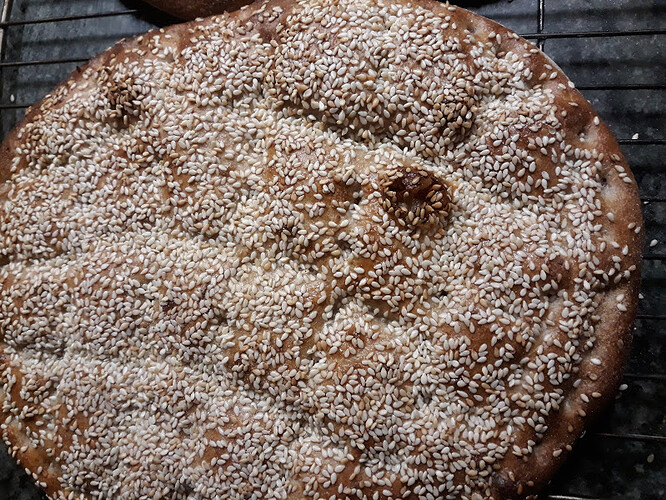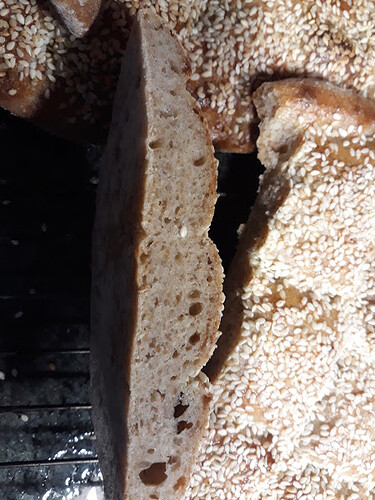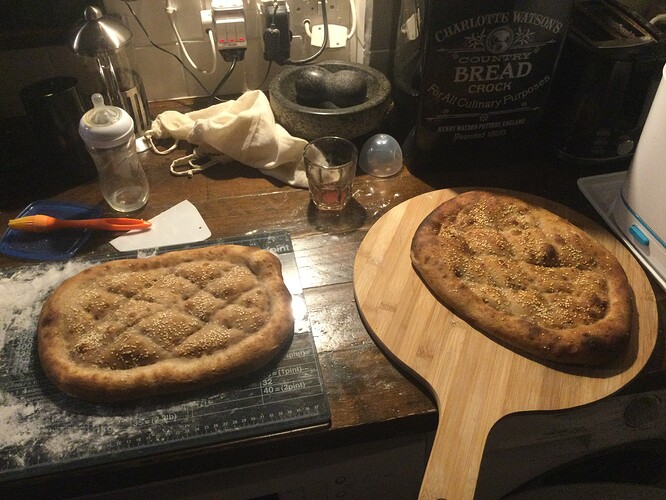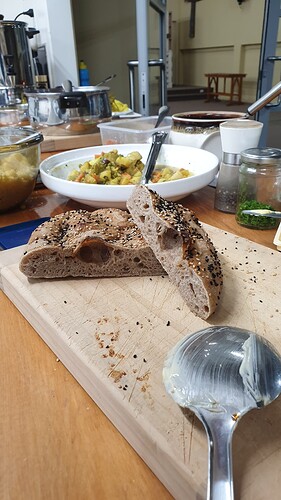The starter was 100% hydration. Bolted flour does have more bran and germ in it than “white” flour, but it sounds like a good next step to get at the texture you want without losing too much nutrition.
@Fermentada I am thinking of reducing my home milled flour portion to 80% hydration and keep the bread flour part at 100. All of my grains are sprouted, so my home milled flours are from sprouted grains. What do you think?
When you recommended @roohoohoo to use a lower hydration starter, do you recommend a stiff starter or at what hydration rate?
Thanks,
A
I’m sorry I’m confused. Are you mixing water into the flours in two steps? You write of two hydrations, 80% and 100%. If you write out your proposed ingredients in list form, I can probably asses the plan better.
Slightly thickening sourdough starter can help a person see the expansion of the paste/batter. Some flour is not particularly absorbent, so that 100% hydration starter is quite thin and all the bubbles pop through the surface rather than get trapped. The starter is actually active, but doubling or tripling isn’t apparent. I usually suggest a 1 : 1 : 1.2 feeding. For example, for 50g starter, feed it 60g flour and 50g water. Eventually that becomes 83% hydration.
Thank you Melissa, I am planning on calculating the bread flour at 80% hydration (per your recipe) and the sprouted home milled flour at 70%, then mix all flour and water at the same time. For example, I am planning to use slightly more than half 270g of bread flour @ 80% hydration and the remainder of the flour will be home milled, 250g @70% hydration. The home milled flour will be from sprouted grains. I often like to use a mixture of grains, buckwheat, red fife, rye, and spelt in this case.
I missed typed earlier, I don’t mean 100 & 80, should be 80 & 70 hydration rates
So will have:
270g bread flour
250g home milled flour
391g of water
All the rest of the ingredients on from the recipe remain the same
Thanks,
A
Gotcha I can now see what you mean. I’d again caution equating sifted flour with bread flour in terms of dough feel. All the flours you’re using will be thirstier and a bit less elastic. I’m guessing you reduced the total water in the recipe despite this absorbency and because of the less elastic part. If you have a substantial amount of low- and no-gluten grains in the home-milled component, it is probably safer to go dryer when the gluten strength is low. (I’m referring to the rye and buckwheat.) In the end, it’s less about the numbers and more about how the dough feels and getting the flavor and nutrition profile that you want. 
I thought pretty much all bread flour are sifted/bolted, at different percentages. The bread flour I have is bolted. Yes, I normally use a good percentage of buckwheat and thought it would be safer to reduce the hydration rate for the home milled portion. I use a lower percentage of rye in most of my dough, but normally a small/low percent.
It might have been my proofing last time as well.
Thank you for your help, I will report back
A
You’re welcome. I look forward to hearing how it goes.
Here’s a blog post that explains the differences between sifted/bolted stone ground flour and refined roller milled (high gluten) bread flour. The title says “newbie” but it’s for experienced bakers too 
Yes, it appears from this article that sifted and bolted are inter-changeable terms. “The flour that results from this sifting is variously called “sifted,” “bolted,” “high extraction,” and in Europe often referred to via various numbered “types” of flour (e.g. French T80, German Type 1050, Italian Type 1).”
I made my second attempt with the pide, it turned out better today, but still not airy enough. As you said, the whole grains would make it more dense.
Do you have any tips from these pictures?
That looks great! I think with the flours you’re using, that is a wonderful crumb. You can try using more water and doing more gluten development, but I’m not sure that will get more air into the final bread.
This is such a great recipe! I was worried mine had overproofed, as the dough was incredibly soft but it puffed up beautifully in the oven. I had some leftover pomegranate juice so used that for the glaze, which worked very well and gave it a good colour.
The texture of the crumb is wonderful - so tender and fluffy. Better than any pide I’ve ever bought! Thanks Melissa.You’re welcome! That looks delicious 
I can’t tell from the recipe if I’m to use 75g EACH of the rye, einkorn and winter wheat??
I’m sorry for the confusion. It’s “or” so just 75g whole wheat flour, any of those varieties or others are fine too.
Made a wholemeal version. Home milled grains, bran partly removed with fine sift. Added 2 Tbsp of gluten flour.
Beautifully soft, nice holes.
Made a few versions. The one where it was put back into the incubator for 20 min after forming the loaf just before baking had the biggest holes.
Fun recipe for a lazy Sunday at home. Thanks for sharing
In the tabs at the top of the comment box it’s the seventh from the left and sixth from the right. Little oblong box with a picture inside. Click on it and follow to upload. You can always try drag and drop.
That’s lovely! Thanks for sharing the method/ingredients and photos.





